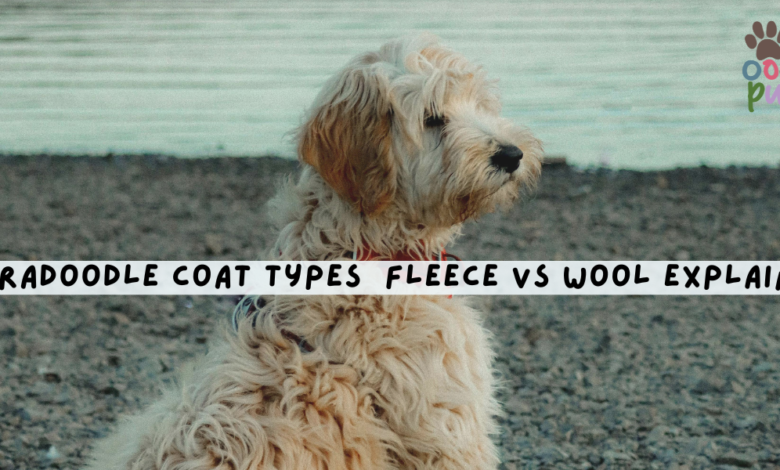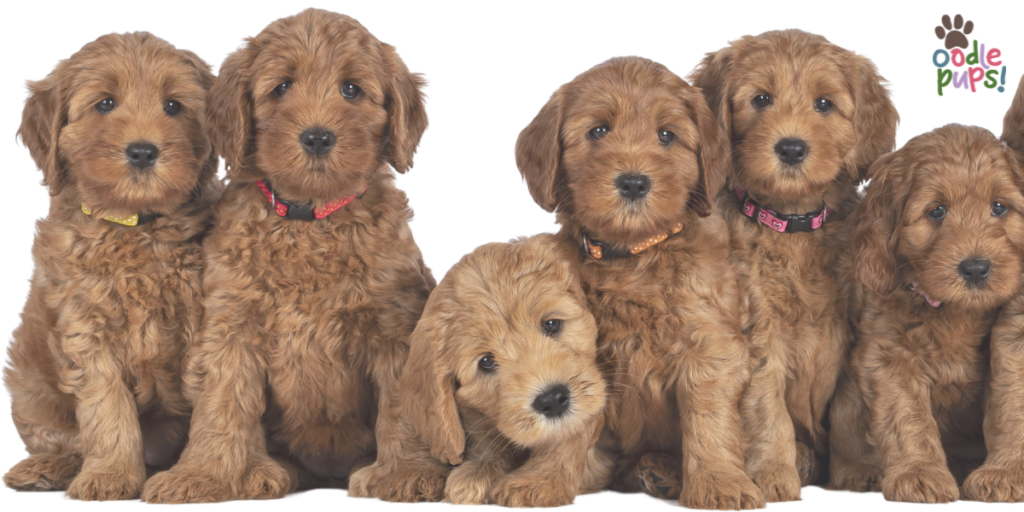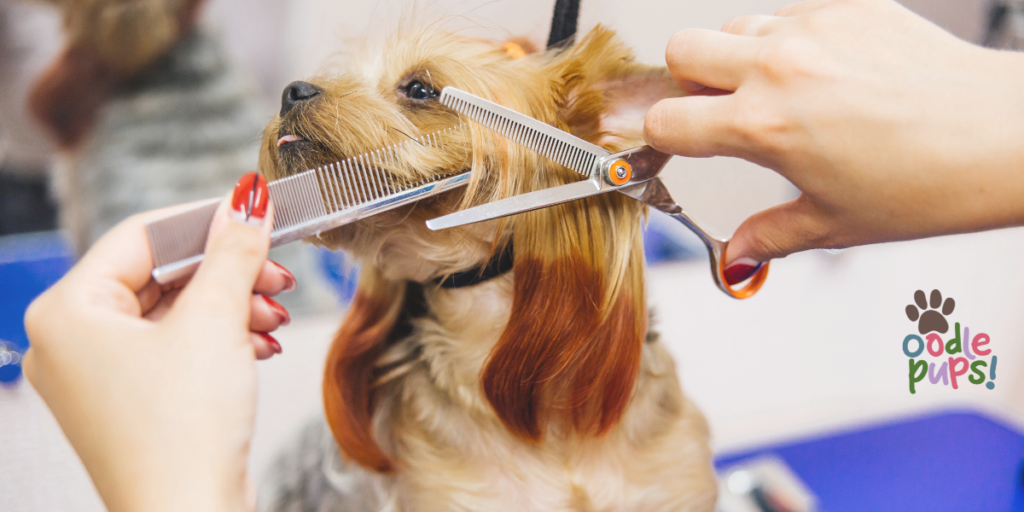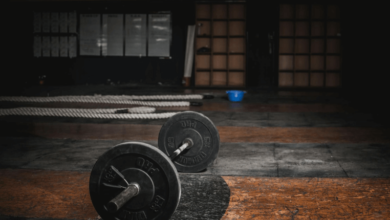Labradoodle Coat Types: Fleece vs Wool Explained

What’s the deal with Labradoodle coats anyway? One minute you’re looking at a silky, wavy pup, and the next you’re staring at what looks like a walking cotton ball.
If you’re scratching your head over fleece versus wool coats, you’re in good company. We get calls every week from families who feel totally overwhelmed by coat choices.
Our experience at oodle pups has taught us that fleece coats need brushing twice weekly, while wool requires daily attention to prevent matting. That’s why choosing the wrong coat type can make your dream dog a grooming nightmare.
In this guide, you’ll get to know:
- The main Labradoodle coat types explained
- How puppy coats change as they mature
- Daily grooming needs for each coat variety
- Professional grooming tips that work
Read on to make your best choice yet.
Types of Coat in Labradoodle
There are three main coat varieties you’ll encounter when looking at Labradoodles: fleece, wool and hair. Among these three Labradoodle coat types, fleece and wool are most popular, but hair type is also worth understanding before you choose your pup.

While many people think all Labradoodles look the same, the truth is each variety brings its own personality, maintenance needs, and benefits to your family.
Here’s what you need to know about fleece, wool, and hair coats.
The Fleece Coat
Do you know that the fleece coat is the most sought-after among Labradoodle owners? If you don’t, then you’re missing out on why most families fall head over heels for this texture. When we talk about Labradoodle coat types, fleece consistently tops the popularity list at our breeding program.
What makes a fleece coat so special is that it can be either wavy or curly, and a lot of people compare it to a comfy fleece blanket. It’s like petting a cloud that somehow learned to fetch your slippers. The texture feels soft between your fingers without that wiry feeling some coats have.
The best part is that it’s generally a non-shedding coat, which is great for people with pet allergies. So your furniture stays cleaner, and those midnight sneezing fits become a thing of the past.
The Wool Coat
Let’s take a closer look at the dense and curly wool coats of the Labradoodle. This coat type feels thicker and more substantial than fleece, almost like touching an actual sheep’s fleece. The tight curls create a barrier that traps skin cells and dander close to the body rather than floating around your home.
However, this density means more work for you. The reason is simple: daily brushing becomes necessary because those tight curls love to tangle themselves into impossible knots. The wool coat requires commitment, but families who stay on top of grooming find it incredibly rewarding.
We recommend wool coats for experienced dog owners who enjoy the grooming process. If your family is new to Labradoodles, you may find the maintenance overwhelming at first.
The Hair Coat
The hair coat is the least common among Labradoodle coat types, but it’s important to understand its characteristics. It’s because this coat can surprise families who expect that classic Labradoodle look but end up with something completely different.
Also, this coat is similar to a Labrador’s, with a coarser texture and long hair that can be straight or a little wavy. Unlike the fleece and wool coats, this hair coat does shed, so it’s not the best choice if you have allergies.
If you now get the basics of each coat type, let’s explore how these coats change as your puppy grows up.
The Labradoodle Puppy Coat to Adult Coat Transition
The change from a soft puppy fluff to a beautiful adult coat is a journey every owner experiences. When you’re trying to decide between fleece and wool options, remember that what you see at eight weeks old might look completely different at eight months old.
For example, our Rosie had the softest puppy coat that felt like silk, but by her first birthday, she’d developed gorgeous fleece waves. The reality is, many families feel surprised by how dramatically their pup’s appearance shifts during this time.
Consider this transition period when planning your grooming routine and expectations.
- Predicting Adult Coats: Predicting a puppy’s adult coat is like a guessing game for many new owners. The reason this happens is that a puppy’s soft coat can change a lot as they get older, so it’s hard to tell what it will be like. Though breeders can give you some clues based on genetics, you won’t see the final coat type until they’re about a year old.
- Genetic Factors: The coat type a puppy gets depends on the genes from its parents, the Labrador and the Poodle. If your puppy has more Poodle genes, it’s more likely to have a desirable wool or curly fleece coat. But if the Labrador genes dominate, you might end up with that straighter hair coat instead.
What makes this even uncertain is that first-generation Labradoodles (F1S) are a direct cross, so their coat is the most unpredictable of all. Think of it like rolling dice because you never know which parent’s traits will win out until your pup matures.
Once you understand coat development, the next step is learning how to care for whatever coat your Labradoodle develops. The right grooming approach can make or break your experience as an owner.
Read Also: Techoelitecom: Exploring the Tech Elite
Grooming and Maintenance for Labradoodle Coats
What’s the secret to keeping your Labradoodle looking like they just stepped out of a grooming salon? Well, it’s regular maintenance that keeps coats silky smooth and prevents those expensive emergency grooming visits.

Here’s the thing, though: fleece and wool varieties need different care approaches, but both demand consistent daily brushing. You can’t just brush once a week and hope for the best with these coat types.
Here are the essential grooming habits that will keep your pup comfortable and looking their absolute best:
Regular Brushing and Combing
Daily brushing prevents painful mats that can pull on your dog’s skin and cause serious discomfort. While both fleece and wool coats need thorough brushing sessions, wool requires extra attention because those tight curls trap loose hair easily.
What works best is to start at the skin level and work your way out to catch tangles before they become impossible knots. In this way, you’re removing loose hair before it can weave itself into the existing coat. So no more wrestling with stubborn mats that hurt your dog.
Useful tip: Always brush your Labradoodle when their coat is completely dry. When you brush wet hair, it stretches and breaks more easily, which can damage the coat structure over time.
Professional Grooming
While daily brushing helps at home, professional grooming every 6-8 weeks keeps your Labradoodle in top shape. This is where groomers trim problem areas, clean ears thoroughly, and maintain nail health in ways you might miss at home.
Most groomers offer several popular cuts that work beautifully with these coat types:
- Classic “teddy bear” cut
- Puppy clip style
- Lamb trim variation
What’s great about professional care is that fleece coats work particularly well with professional styling because the texture holds its shape longer than other varieties. Plus, groomers know how to work with long hair sections while keeping the overall look balanced and proportioned.
After maintaining this routine for a few months, you’ll see your dog strut around like they own the neighbourhood. They know they look good, and so will everyone else.
Making the Right Choice for Your Family
Labradoodle coat types offer distinct options that may confuse first-time buyers. However, whether you’re drawn to fleece or wool varieties, the right information helps you pick the perfect match for your lifestyle and grooming preferences.
We’ve walked through the three main coat types, how puppy coats develop into adult varieties, and the grooming routines that keep each type healthy and beautiful. The differences between fleece and wool become clearer when you understand their unique characteristics.
You now know how to make an informed decision about your future companion. Still, if you need guidance choosing between fleece and wool options, our experienced team stands ready to help you find your ideal companion.





